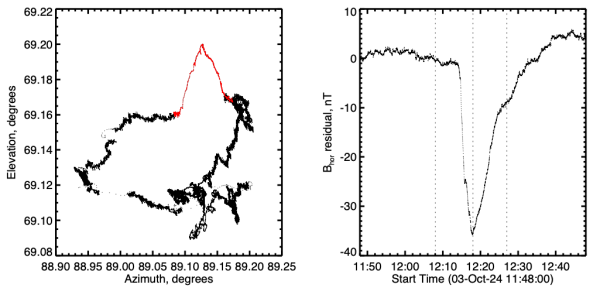An X9 flare and its huge crochet (SFE)
| Nugget | |
|---|---|
| Number: | 472 |
| 1st Author: | Hugh HUDSON |
| 2nd Author: | |
| Published: | October 7, 2024 |
| Next Nugget: | Non-neutralized coronal currents |
| Previous Nugget: | All microflares that accelerate electrons to high energies are rooted in sunspots |
Introduction
The legendary Carrington flare (Ref. [1]) produced an equally legendary geomagnetic effect, and thus "space weather" could have been born then and there. The geomagnetic effect, we now know, results from solar X-rays perturbing the ionosphere. But nobody in 1859 knew anything about X-rays or ionospheres, and the simultaneity of the powerful flare and its geomagnetic effect, though noticed at the time, remained unexplained for decades. Early geomagneticians began to call the subsequently noticed flare-related wiggles "crochets" - colorful terminology now replaced by "SFE" for "Solar Flare Effect". These only amount to a few nT, a few hundredths of 1% of the Earth's unperturbed magnetic field.
The powerful flare SOL2024-10-03 (X9.0) has capped a wonderful year for fans of solar flares. It produced the huge SFE that we describe here.
The basic physics, long understood conceptually, consists of the following: The Earth's ionosphere supports electrical currents at altitudes above about 100 km. The EMF needed to drive the currents comes from the global magnetosphere, as driven by the magnetized solar wind blowing across it. When a flare happens, its X-radiation increases the ionization, which in turns supports larger currents, which slightly alter the geomagnetic field. The magnetometer shows this while it happens.
The SFE
We capture the geomagnetic variation produced by SOL2024-10-03 in Figure 1, derived from the Dunsink magnetometer in Ireland. These data show a close match between the magnetometer deflections and the soft X-ray flux as observed by GOES. The minimum in Bhor and the peak in 1-8 Å X-ray flux match to within a minute.

The hodogram representation is a bit complicated and seldom seen in this context, but quite informative. The geomagnetic field vector points roughly upwards at Dunsink. Its direction varies slightly with time; the hodogram shows these motions very precisely via two angles, azimuth and elevation. Over the one full day of the left panel in Figure 1, one can see the vector motion corresponding to the diurnal variation, whose discovery constituted the very first "multimessenger" astrophysics (Ref. [2]).
This flare's hodogram hints at the complexity of the ionospheric reaction to the flare, which depends on several factors. Interestingly, in this case the magnetic vector does not return to its pre-flare direction, showing the presence of a long-term alteration of the ionospheric/magnetospheric current system (and magnetic structure). In principle one can evaluate these global effects by employing data from multiple geomagnetic sites, now freely available from Intermagnet.
Conclusions
What can we do with these data? Importantly, we can now calibrate the Carrington flare's total energy (see Ref. [3]) by using the original 1859 SFE measurement and the current one, taking advantage now of the modern global data coverage and better understanding of the physics.. The Carrington flare, needless to say, has inspired numerous science-fiction stories and movies about solar disasters, and now we can get quantitative about this danger.
Acknowledgments
This Nugget anticipates forthcoming detailed analysis of this major SFE in the context of the the Carrington flare by the author, Ed Cliver, Peter Gallagher, and Hisashi Hayakawa.
References
[1] "The 1859 space weather event revisited: limits of extreme activity"
[2] "Commentary: Multimessenger solar astrophysics"
[3] "Magnitude Estimates for the Carrington Flare in 1859 September: As Seen from the Original Records"